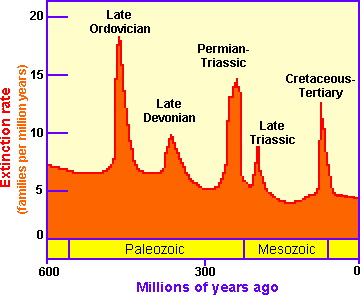
MODULE 13: Extinction
Objectives: In this module you will learn about how the fossil record provides us with direct evidence of the extinction of species. You will examine the large scale patterns of extinction that have occurred over geologic time focusing on mass extinction intervals, where large percentages of life on earth disappeared. We will explore whether the earth is currently undergoing a mass extinction event driven by human activities and comparable to those in the geologic record.
Background: EXTINCTION is the loss of all individuals of a species over the whole earth. There are two ways in which all members of a species can be lost forever. The first way is Species Extinction, when all individuals die without producing offspring. But what makes a species prone to extinction?? There are many ecological correlates that can influence extinction: Rarity, Dispersal ability, Degree of specialization, Adult survival rate, Niche location, Population variability, Isolation of populations, Trophic status, Longevity, and the Intrinsic rate of population increase.
Dinosaur example: Consider the T-rex.... which of the above ecological correlates might influence this species' extinction??

Top carnivores like T-rex are typically more rare in number, at the top of the trophic pyramid, and specialists in their appetite. If conditions in their environment change in a way that the top of the trophic pyramid is not supported, T-rex extinction becomes more probable. The cheetah is a modern example of an extinction-prone top carnivore..
Species extinction can involve deterministic processes where there is a cause and effect relationships or stochastic processes where chance or random effects plays a role in extinction. The dodo bird went extinct because humans killed it off (deterministic). The late Cretaceous dinosaurs went extinct because of a meteorite (stochastic). Much of the earth's current biodiversity losses may be due to human activities (deterministic).
A second way that species become extinct is pseudo-extinction, where a species' anatomy transforms enough over geologic time so that paleontologists recognize it as a new species. Pseudo-extinction is a phenomena that occurs because there is no way to go back in time and see whether species could interbreed with a sister species so paleontologists define a new species when "significant" morphological change has occurred.
Over geologic time all species have had a finite span of existence. Most species that have ever lived are extinct (approximately 1000:1)! Paleontologists estimate that the average duration of a species is in the millions of years (e.g., 10 million years for marine invertebrates). If we look over the whole paleontological record we find that there is a background extinction rate that indicates how many species are going extinct at any one time versus the number that are originating at any one time. In fact, there appears to be a general increase in species during earth's history, that is, originations seem to outpace extinctions.
Mass Extinctions:
When the number of extinctions at a given time far exceeds the typical background extinction level, we consider this a mass extinction. Mass extinctions have been relatively rare in earth's history although they have had an abrupt impact on the faunal and floral composition of earth. The best recognized mass extinctions over the last 500 million years have occurred during the Late Cambrian (500 ma), the Late Ordovician (430 ma), Late Devonian (345 ma), end of the Permian (225 ma), Late Triassic (190 ma), and the Cretaceous-Tertiary "K-T" (65 ma). The greatest mass extinction was the Permian-Triassic where 77% of all species (e.g., trilobites) died off. During the K-T (Cretaceous-Tertiary) extinction (65 million years ago) 50% of all species (including the Cretaceous dinosaurs except birds) went extinct.

As recently as 12,000 years ago there were a great number of Pleistocene Extinctions that involved large mammals in North America and elsewhere. Currently, many biologists believe that we may be entering a human-generated mass extinction the likes of which has not been seen since the K-T extinction event.